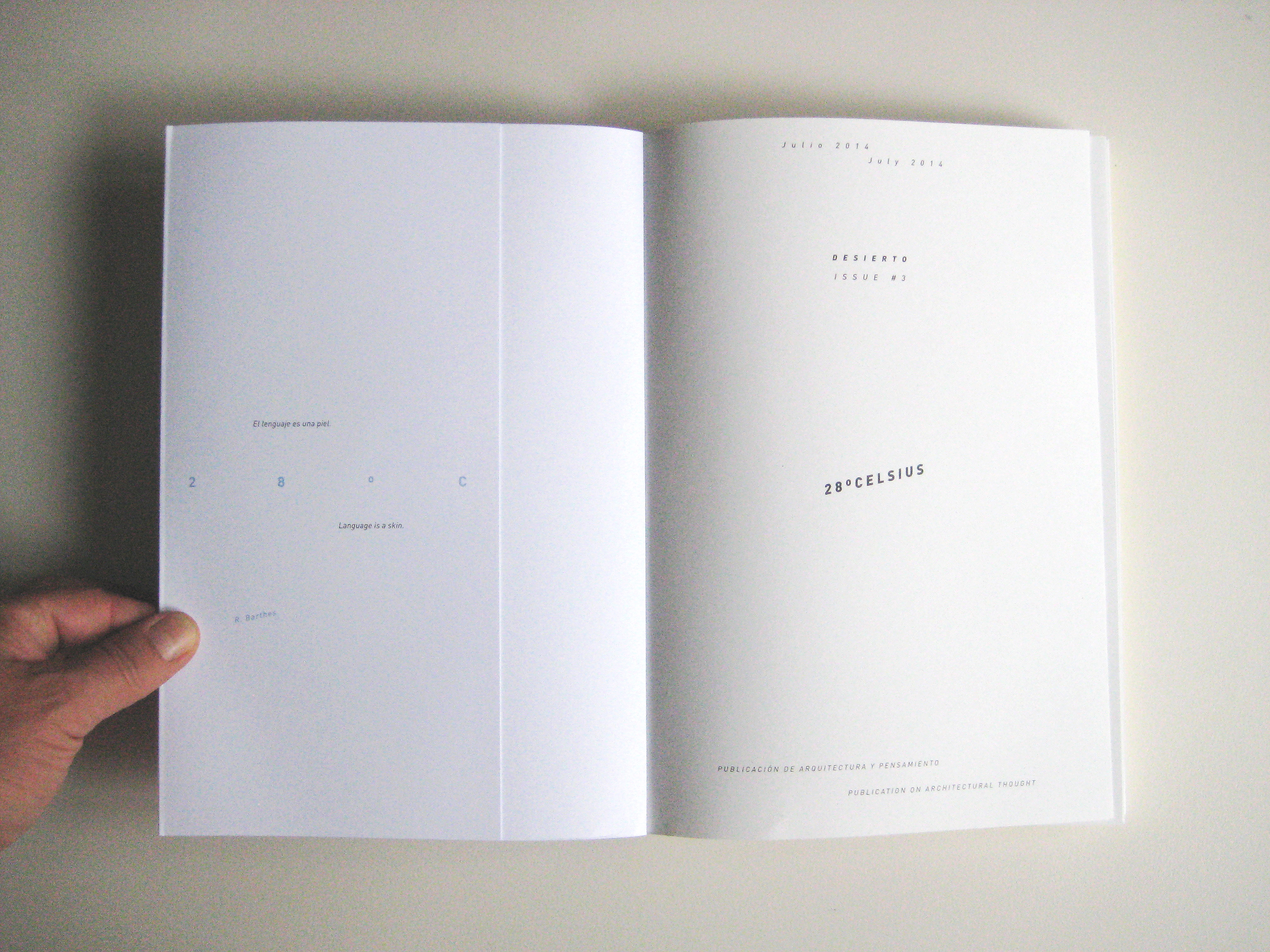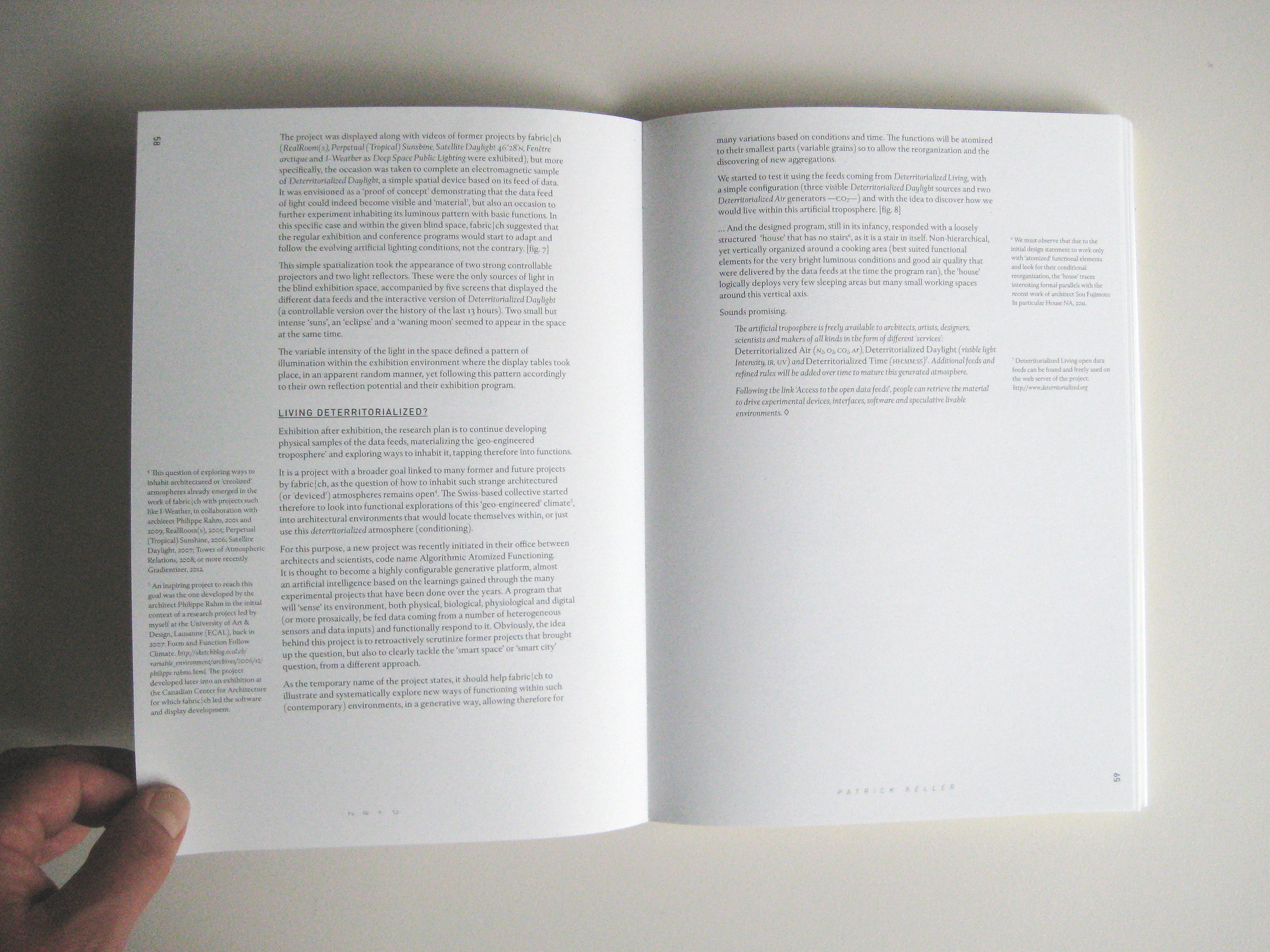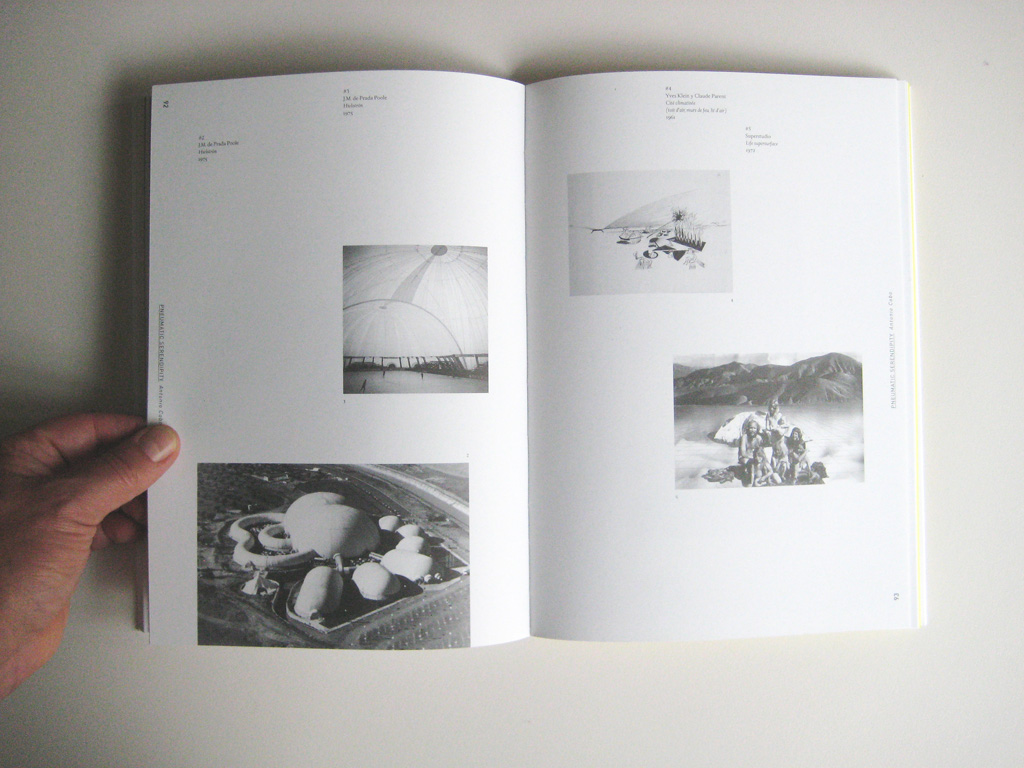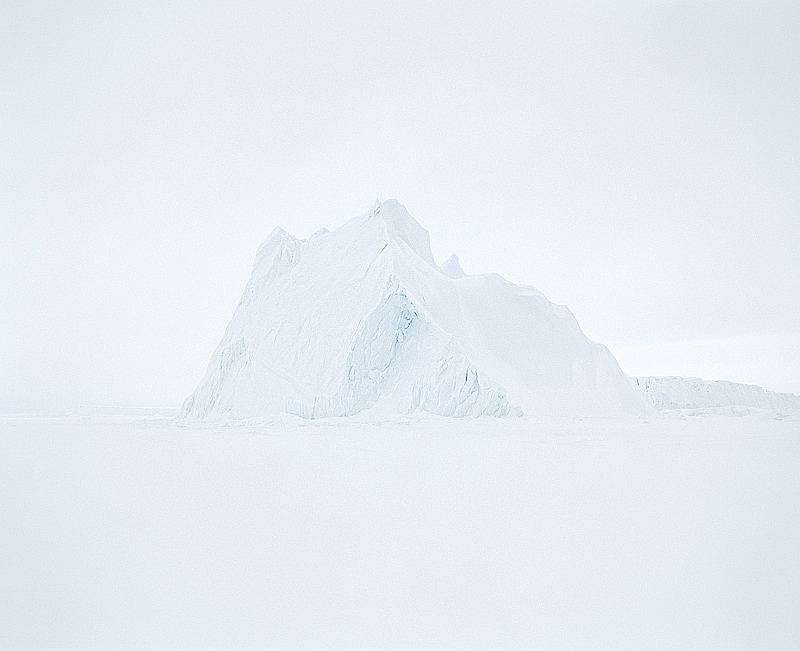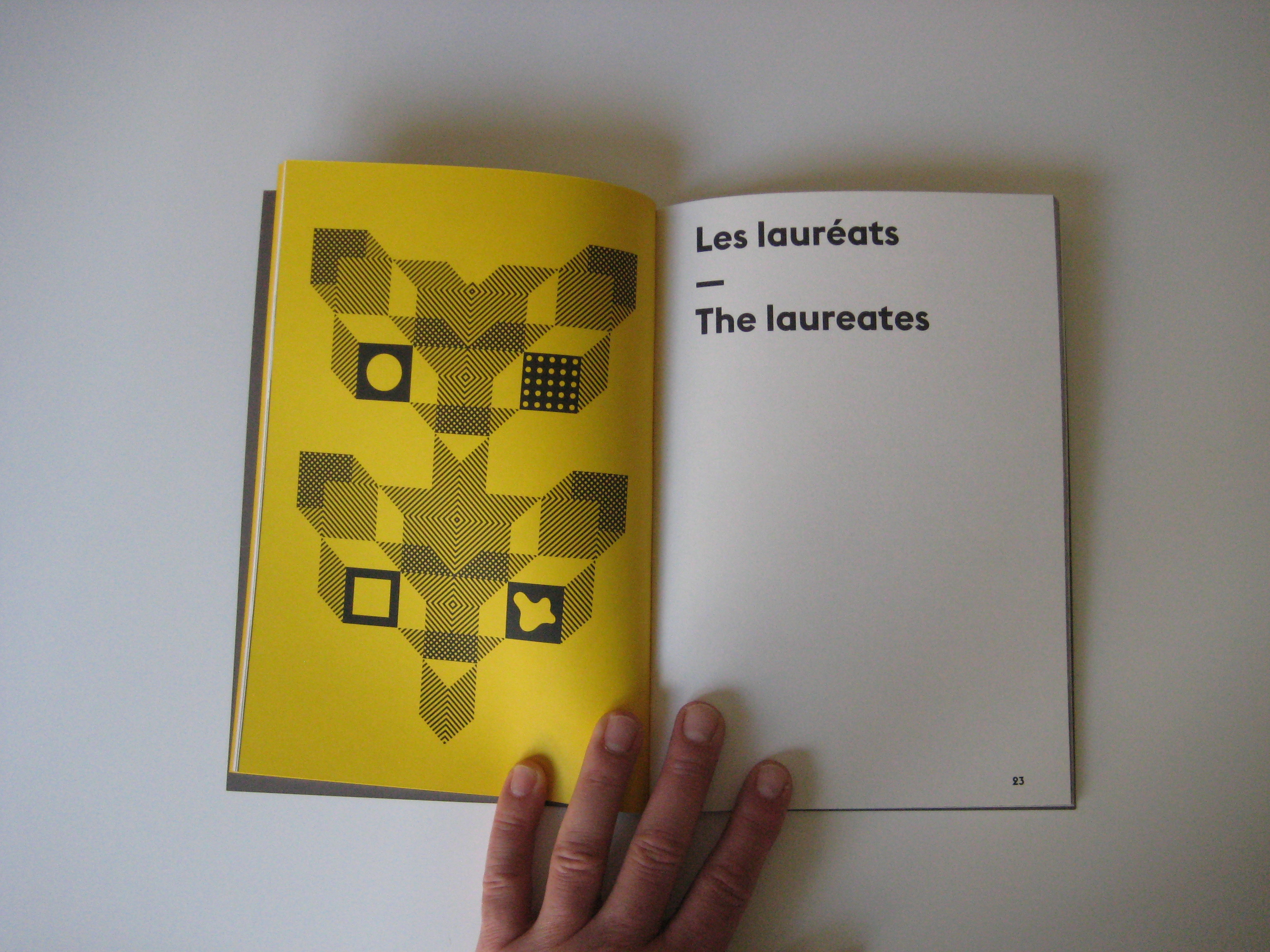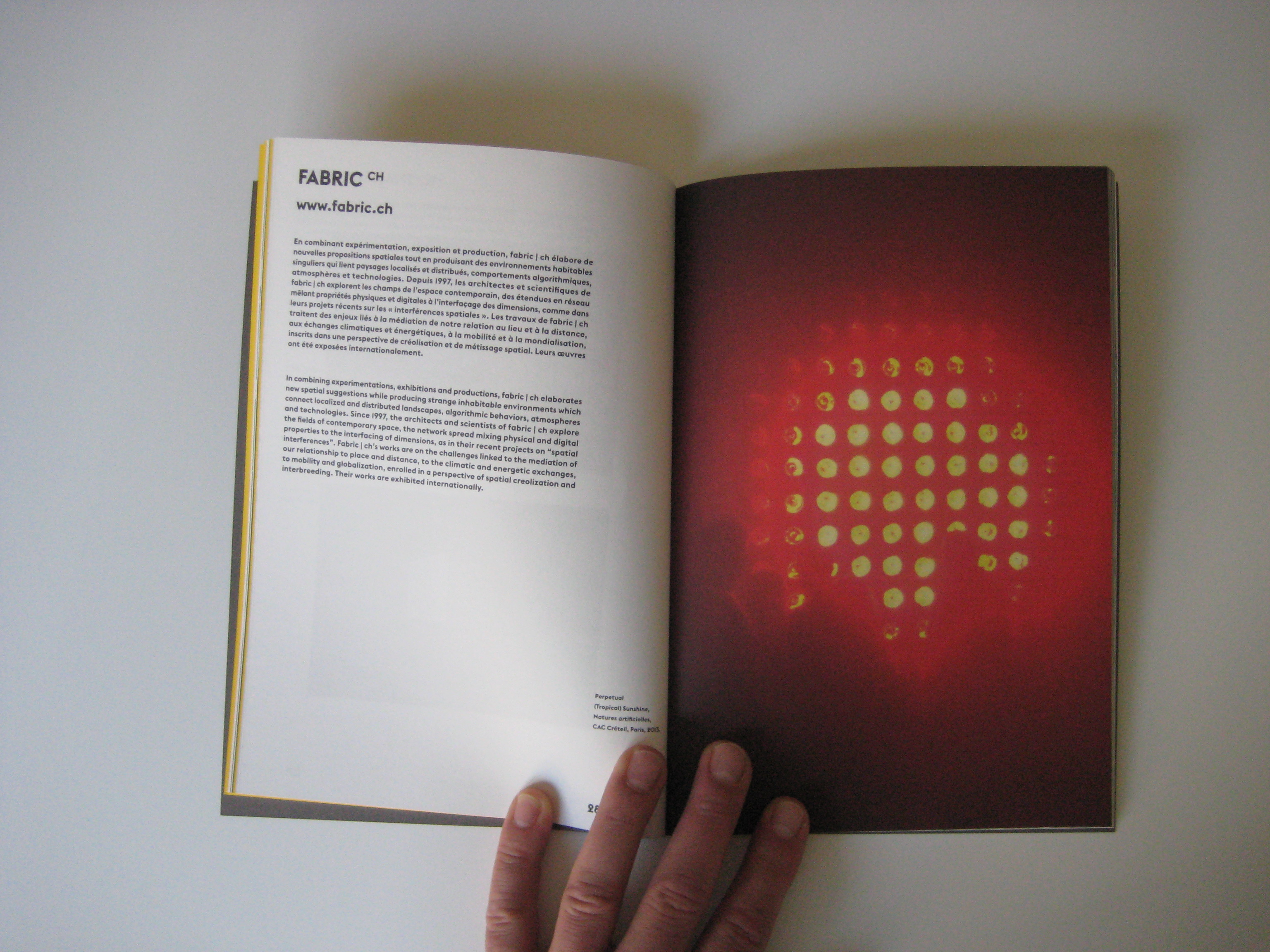Sticky Postings
All 242 fabric | rblg updated tags | #fabric|ch #wandering #reading
By fabric | ch
-----
As we continue to lack a decent search engine on this blog and as we don't use a "tag cloud" ... This post could help navigate through the updated content on | rblg (as of 09.2023), via all its tags!
FIND BELOW ALL THE TAGS THAT CAN BE USED TO NAVIGATE IN THE CONTENTS OF | RBLG BLOG:
(to be seen just below if you're navigating on the blog's html pages or here for rss readers)
--
Note that we had to hit the "pause" button on our reblogging activities a while ago (mainly because we ran out of time, but also because we received complaints from a major image stock company about some images that were displayed on | rblg, an activity that we felt was still "fair use" - we've never made any money or advertised on this site).
Nevertheless, we continue to publish from time to time information on the activities of fabric | ch, or content directly related to its work (documentation).
Wednesday, July 14. 2021
Interview with Patrick Keller – fabric | ch, HEK Blog (Basel, 2020) | #satellite #daylight #device
Note: Patrick Keller (fabric | ch) was in discussion with curator Sabine Himmelsbach, from Haus der elektronischen Künste in Basel (CH), about their new acquisition for the collection of the Museum: Satellite Daylight 47°33'N.
The piece will be displayed permanently in the public space of the HeK. At least until breakdown... But interestingly, it is also part of a whole program of digital conservation at HeK that should prevent its technological collapse, for which we had to follow a tight protocol of documentation and provide the source code pf the work.
-----

fabric | ch, Satellite Daylight, 47°33‘N, 2020, Vue de l'installation durant «Shaping the Invisible World», 2021, HeK. Photo.: P. Keller.
Shooting set in preparation ...

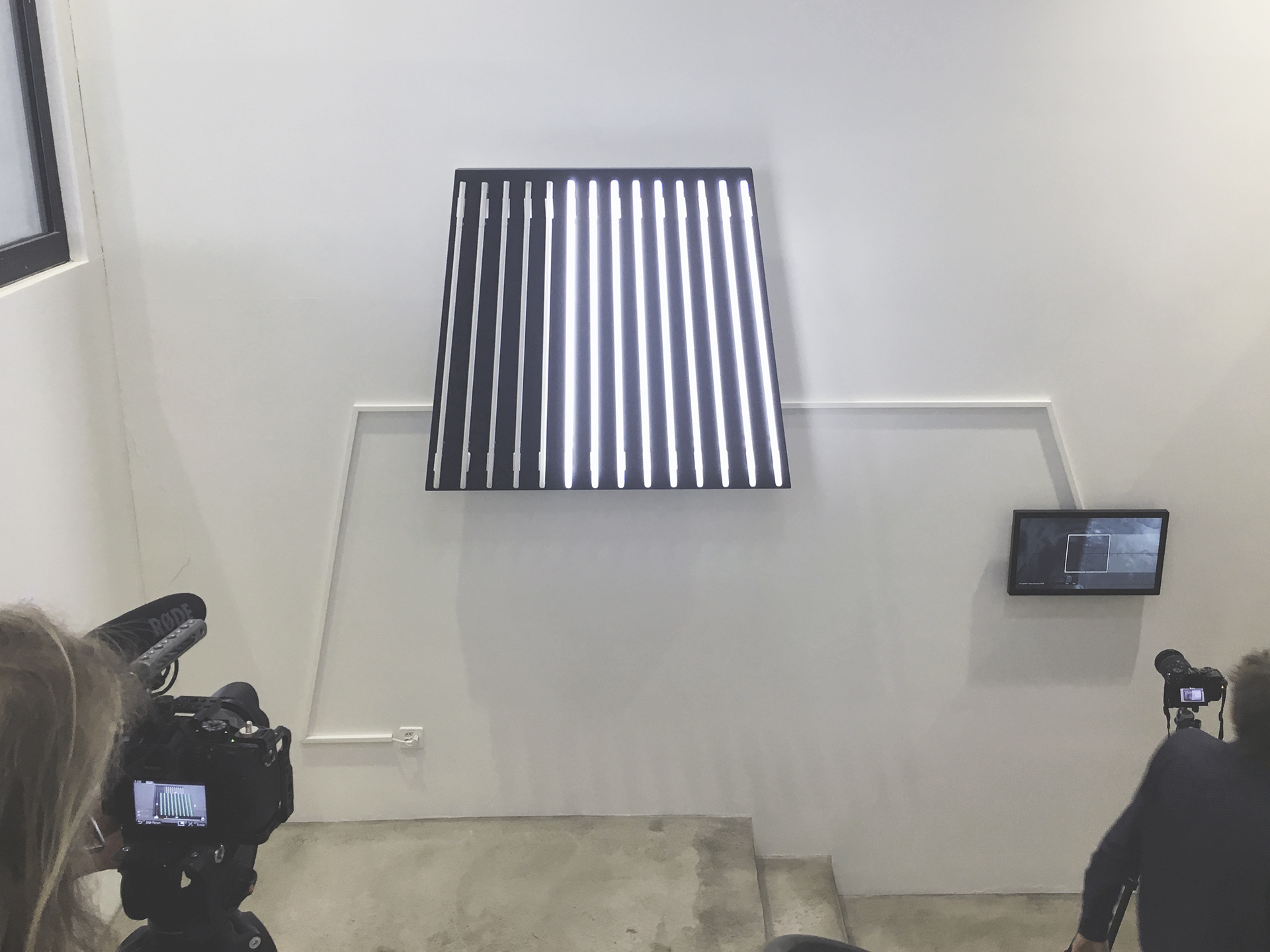
Followed by our discussion with Sabine Himmelsbach ... (with a lot of reverb in the staircase!)
-----
Via Haus der elektronischen Künste (blog)
Patrick Keller of fabric | ch, a studio for architecture, interaction and research in Lausanne, provides thrilling insight about the new work installed in the staircase of HeK.
Patrick Keller of fabric | ch, a studio for architecture, interaction and research in Lausanne, provides information about the new work in an interview. The installation Satellite Daylight, 47°33’N, commissioned for the HeK collection, simulates the light registered by an imaginary meteorological satellite orbiting the earth at the latitude of Basel at a speed of 7541m/s.
Friday, May 12. 2017
The World’s Largest Artificial Sun Could Help Generate Clean Fuel | #conditioning #energy
Note: an amazing climatic device.
For clean energy experimentation here. Would have loved to have that kind of devices (and budget ;)) when we put in place Perpetual Tropical Sunshine !
-----

Don’t lean against the light switch at the Synlight building in Jülich, Germany—if you do, things might get rather hotter than you can cope with.
The new facility is home to what researchers at the German Aerospace Center, known as DLR, have called the “world's largest artificial Sun.” Across a single wall in the building sit a series of Xenon short-arc lamps—the kind used in large cinemas to project movies. But in a huge cinema there would be one lamp. Here, spread across a surface 45 feet high and 52 feet wide, there are 140.
When all those lamps are switched on and focused on the same 20 by 20 centimeter spot, they create light that’s 10,000 times more intense than solar radiation anywhere on Earth. At the center, temperatures reach over 3,000 °C.
The setup is being used to mimic large concentrated solar power plants, which use a field full of adjustable mirrors to focus sunlight into a small incredibly hot area, where it melts salt that is then used to create steam and generate electricity.
Researchers at DLR, though, think that a similar mirror setup could be used to power a high-energy reaction where hydrogen is extracted from water vapor. In theory, that process could supply a constant and affordable source of liquid hydrogen fuel—something that clean energy researchers continue to lust after, because it creates no carbon emissions when burned.
Trouble is, folks at DLR don’t quite yet know how to make it happen. So they built a laboratory rig to allow them to tinker with the process using artificial light instead of reflected sunlight—a setup which, as Gizmodo notes, uses the equivalent of a household's entire year of electricity during just four hours of operation, somewhat belying its green aspirations.
Of course, it’s far from the first project to aim to create hydrogen fuel cheaply: artificial photosynthesis, seawater electrolysis, biomass reactions, and many other projects have all tried—and so far failed—to make it a cost-effective exercise. So now it’s over to the Sun. Or a fake one, for now.
(Read more: DLR, Gizmodo, “World’s Largest Solar Thermal Power Plant Delivers Power for the First Time,” “A Big Leap for an Artificial Leaf,” "A New Source of Hydrogen for Fuel-Cell Vehicles")
Wednesday, September 21. 2016
Rainbow Installation Inside Bristol Biennal | #insideovertherainbow
Note: I would definitely like to do the same (or a bit differently with I-Weather --we almost did back in 2012 during 01SJ in San Francisco in fact, but we were missing a bit of light strength compared to the space--)!
Via Fubiz
-----
The artist Liz West continues inventing original and psychedelic installations, this time as part of the Bristol Biennal. Her project Our Colour is composed of filters that allow the lights to change and is a good way to study the reactions of the human brain when confronted to certain luminous atmospheres. After travelling through all the shades, each person usually ends up enjoying his or her favorite one.
Related Links:
Wednesday, October 08. 2014
Desierto Issue #3 - 28° Celsius is out! Deterritorialized Living included | #atmosphere
Note: a few of our recent works and exhibitions are included in this promising young publication related to architectural thinking, Desierto, edited by Paper - Architectural Histamine in Madrid. At the editorial team invitation, I had the occasion to write a paper about Deterritorialized Living and one of its physical installation last year in Pau (France), during Pau Acces(s). We also took the occasion of the publication to give a glimpse of a related research project called Algorithmic Atomized Functioning.
By fabric | ch
-----
From the editorial team:
"The temperature of the invisible and the desacralization of the air. 28° Celsius is the temperature at which protection becomes superfluous. It is also the temperature at which swimming pools are acclimatised.
Within the limits of the this hygrothermal comfort zone, we do not require the intervention of our body's thermoregulatory mechanisms nor that of any external artificial thermal controls in order to feel pleasantly comfortable while carrying out a sedentary activity without clothing.
28° Celsius is thus the temperature at which clothing can disappear, just as architecture could."
.jpg)
.jpg)
Authors are Gabriel Ruiz-Larrea, Sean Lally, Philippe Rahm, Nerea Calvillo, myself, Helen Mallinson, Antonio Cobo, José Vella Castillo and Pauly Garcia-Masedo.
.jpg)
Editorial by gabriel Ruiz-Larrea (editor in chief). Editorial team composed of Natalia David, Nuria Úrculo, María Buey, Daniel Lacasta Fitzsimmons.
.jpg)
.jpg)
.jpg)
.jpg)
Inhabiting Deterritorialization, by Patrick Keller, with images of Deterritorialized Living website, Deterritorialized Daylight installation (Pau, France) and Algorithmic Atomized Functioning.
Desierto #3 and past issues can be ordered online on Paper bookstore.
Wednesday, May 07. 2014
Vanishing Ice | #photo #book
Monday, March 17. 2014
Air public | #atmosphere #health #public
Via Le Monde, via Philippe Rahm Architectes
-----
Par Philippe Rahm
A quelques semaines des élections municipales, il n'a jamais fait aussi beau à Paris. Le soleil brille, il fait chaud et pourtant on nous déconseille de sortir dehors à cause de la pollution de l'air qui atteint des sommets. Mauvaise nouvelle pourdéjeuner en terrasse. C'est assez paradoxal, ce beau temps qui ne l'est en réalité pas. Cela ne va pas de soi et il nous faudra réviser à l'avenir nos critère du beau et du laid, ne plus se fier au perceptible, au soleil, à la température et au ciel bleu, mais plutôt à l'invisible et se dire le matin qu'il fait beau seulement quand le bulletin météo annoncera pour la journée un taux bas de particules fines dans l'air.
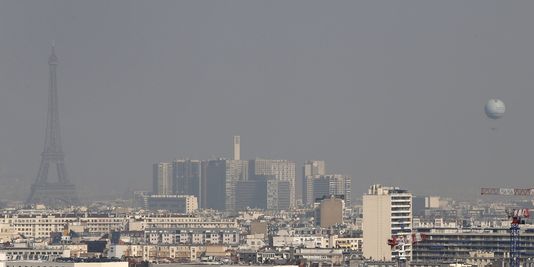
Le nuage de pollution à Paris, jeudi 13 mars. | AP/Christophe Ena
Mais si le bulletin météo classique nous informait de l'état du ciel selon des forces naturelles qui nous dépassaient et contre lequel on ne pouvait choisir que de prendre ou pas son parapluie, le problème de la pollution des villes est une conséquence des activités humaines. Et parce qu'il nous concerne tous, parce qu'il définit la réalité chimique de nos rues et de nos places, parce qu'il menace notre santé, il est éminemment politique. J'affirmerai même qu'il est la raison d'être fondamentale du politique: celle de nous assurer à tous une bonne santé. Le politique est né de la gestion sanitaire de la ville et de la définition de ses valeurs publics que l'on retrouve inscrit aujourd'hui dans les règlements et les plans d'urbanisme: avoir de la lumière naturelle dans toutes les chambres, boire de l'eau potable, évacuer et traiter les déchets et les excréments. En-dessous de son interprétation culturelle, l'Histoire de l'urbanisme et du politique est finalement celle d'une conquête physiologique, pour les villes, pour les hommes, du bien-être, du confort, de la bonne santé.
Et respirer un air sain en ville ? Ne pourrait-on pas penser que c'est finalement cela que l'on demande aujourd'hui au politique ? La demande n'est pas neuve. Au début du XIXe siècle, Rambuteau, préfet de Paris, avait tracé la rue du même nom au coeur du Marais pour faire circuler l'air pour éviter le confinement des germes. Dans sa suite, le préfet Haussmann traçait les boulevards dans un même soucis d'hygiène, y plantait des arbres pour les tempérer, créaient des parcs (les Buttes-Chaumont, le bois de Boulogne, etc.) comme Olmsted avec Central Park à New-York, conçues à la manière de poumons verts pour rafraîchir la ville en été, absorber les poussières et la pollution, améliorer la qualité de l'air, parce qu'à l'époque, on mourrait réellement de tuberculoses et des autres maladies bactériennes dans les villes.
Mais toutes ces mesures sanitaires ont perdu leur légitimité avec la découverte de la pénicilline et la diffusion des antibiotique à partir les années 1950. À quoi cela servait-il encore de raser les petites rues sans air et obscures du Moyen-Âge, de déplacer les habitations dans de vastes parcs de verdure si l'on pouvait chasser la maladie simplement avec un antibiotique à avaler deux fois par jour durant une semaine. Etait-ce vraiment raisonnable d'élargir les petites fenêtres des vieilles maisons en pierre, d'enlever les toits en pentes pour en faire des toits terrasses, si en réalité, on pouvait éviter la maladie avec un peu de pénicilline ?
Si l'on a arrêté de démolir les vieux quartiers des villes européennes à partir des années 1970, si on a commencé à trouver du charme aux ruelles tortueuses et aux vieilles maisons étroites du Moyen-Âge, aux intérieurs sombres et humides des centres villes, si les prix des arrondissements historiques que tout le monde désertait jusqu'aux années 1970 ont commencé à grimper, si des mesures de protections du patrimoine ont été votées, si ces vielles pierres sont devenues des témoins de notre civilisation et un atout touristique et économique, si l'on est revenu habiter les vieux centres historiques, on le doit peut-être autant aux théories post-modernes de Bernard Huet, l'architecte des la place Stalingrad et des Champs-Elysées dans les années 1980, qu'à la découverte médicale des antibiotiques.
Mais les antibiotiques ne peuvent rien contre la pollution aux particules fines d'aujourd'hui. Cela veut-il dire que nous allons assister au même phénomène que durant la première partie du XXe siècle, celle d'une désertion des centre-villes, d'une perte de valeur immobilière des quartiers centraux de Paris, au profit des banlieues et des campagnes où l'air n'est pas polluée ? La ville que l'on a réappris à aimer et à habiter à la fin du XXe siècle va t-elle retombée dans la désolation ? On peut tenter de croire, dans un monde globalisé, que la mission de la politique locale est aujourd'hui de réduire le chômage ou de diminuer les impôts. Mais plus profondément, le politique se doit aujourd'hui de reprendre en main sa mission fondamentale, celle d'assurer la qualité de nos biens publics, celle de nous offrir en ville, après l'eau et la lumière, un air de qualité, seule garantie pour la prospérité sociale et économique future.
Philippe Rahm construit en ce moment un parc de 70 hectares pour la ville de Taichung à Taiwan, livré en décembre 2015 qui propose d'atténuer la chaleur, l'humidité et la pollution de l'air par l'emploi du végétal et de technologies vertes.
Philippe Rahm (Architecte et enseignant aux Universités de Princeton et Harvard (Etats-Unis))
Related Links:
Monday, February 17. 2014
Where The Alps Are A 3D-Printed Landscape Made From Artificial Snow | #
Via BLDGBLOG
-----
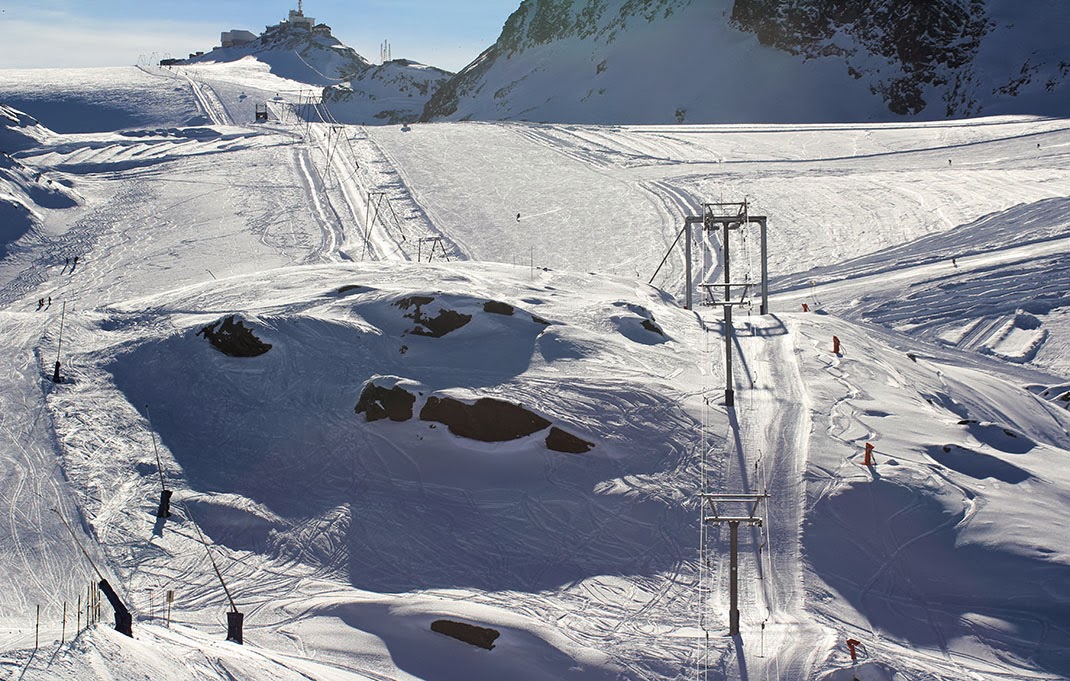
[Image: Photo by Danny Lane].
Earlier this winter, I missed an opportunity to travel over to Switzerland with architects Smout Allen and Kyle Buchanan who, at the time, were leading their students around the mountain landscapes of the Alps in order to learn about infrastructures of defense and national snow-production, among other things. It sounded like an amazing trip.
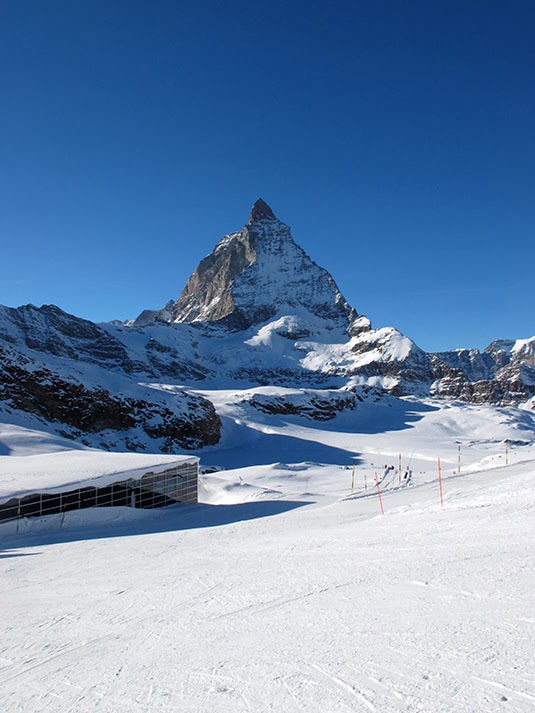
[Image: Photo by Kyle Buchanan].
However, I did get to see some photos sent back of the various and random things they visited in the resort city of Zermatt.
This included a huge machine known as The Snowmaker. Apparently originating in Israel, it was formerly used to cool South African diamond mines but since repurposed for spraying artificial snow onto ski slopes in the Alps.

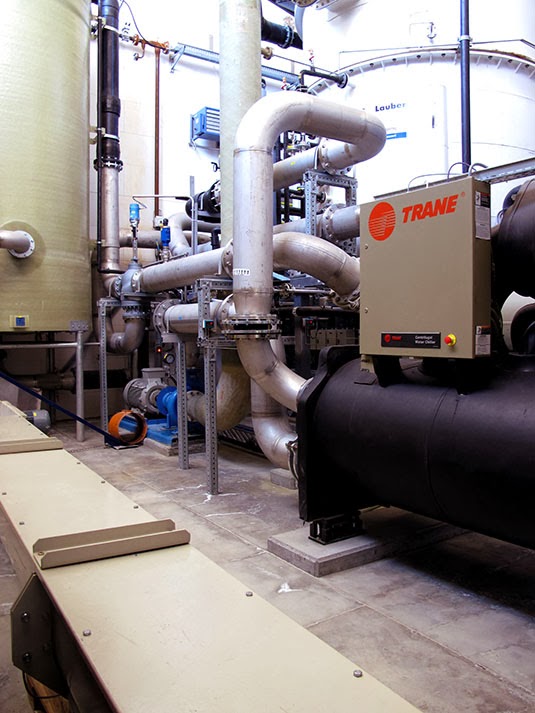
[Images: Photos by Kyle Buchanan].
The carefully choreographed operation requires a fan-like array of buried water pipes, pipes that spread throughout the resort like capillaries.
Snow—or what passes for it—then sprays out of thin, reed-like valves called "lances"—

[Image: Photo by Kyle Buchanan].
—resulting in other-worldly piles of fresh white powder, perfectly sculpted domes that later require selective placement elsewhere.
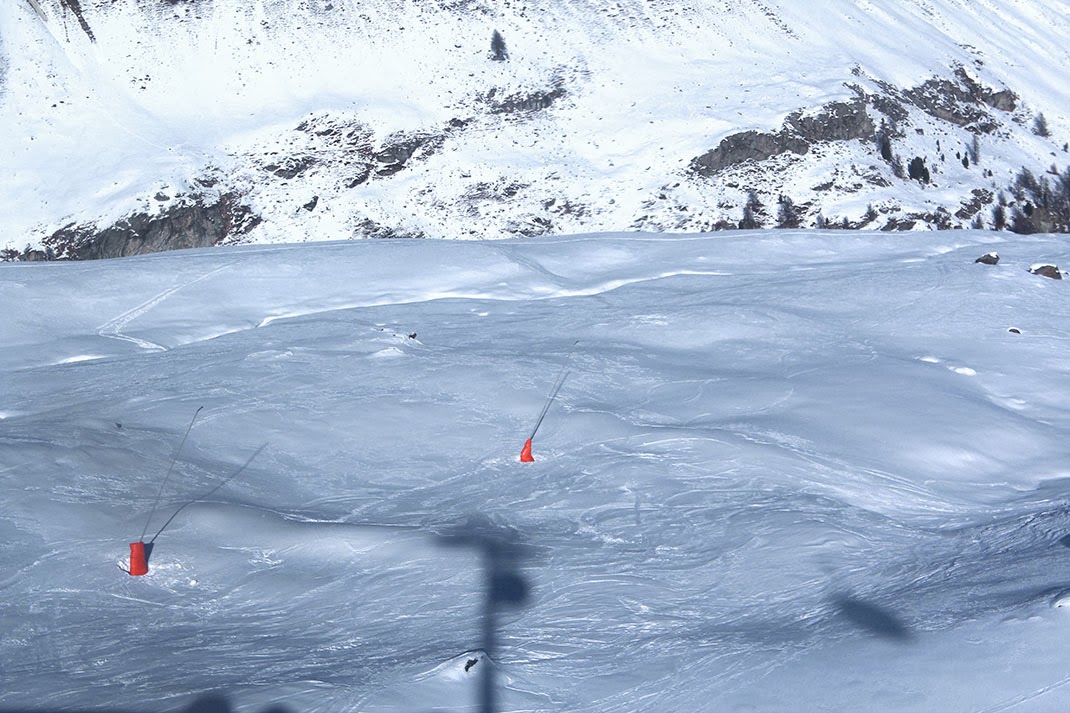

[Images: Photos by Danny Lane].
The shaping of the mountain landscape—so easily mistaken for nature—exhibits obvious features of artificiality, including careful lines and striated grooves resulting from deposition, sculpting, and maintenance.
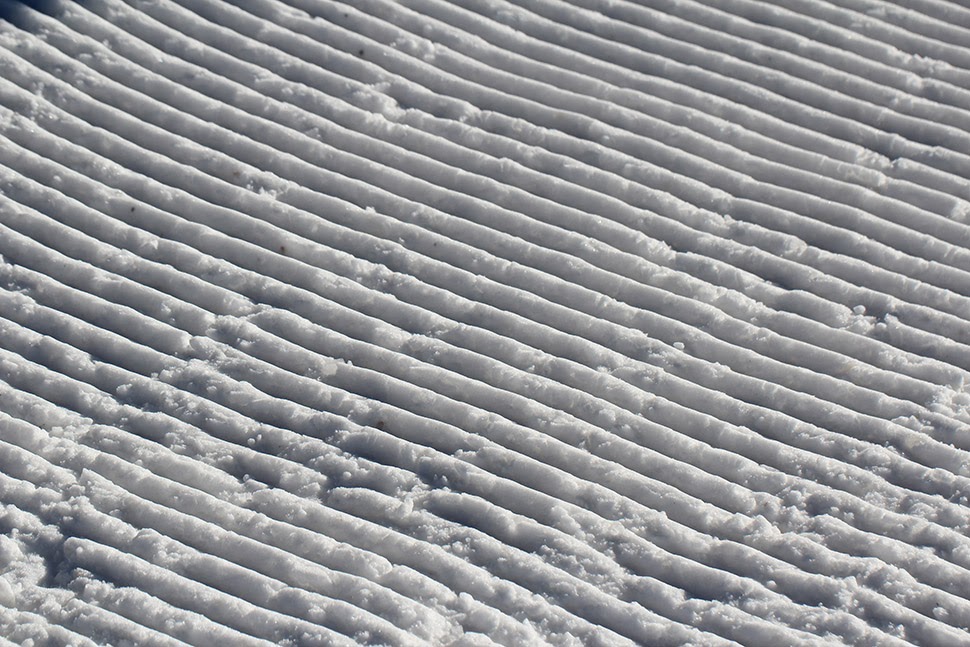
[Image: Photo by Danny Lane].
The machine is literally an oversized air-conditioning unit, waiting to be put to use by landscape-printing crews whose work is mistaken for winter. It so efficiently—though inadvertently—produced ice while cooling diamond mines in Africa that it has since been put to use 3D-printing popular tourist landscapes into existence, like something out of Dr. Seuss.
To at least some extent, The Snowmaker—and newer technology like it—has replaced older, fan-based snow machines. These thus now sit in a maintenance shed, like antique airplane engines, both derelict and obsolete.
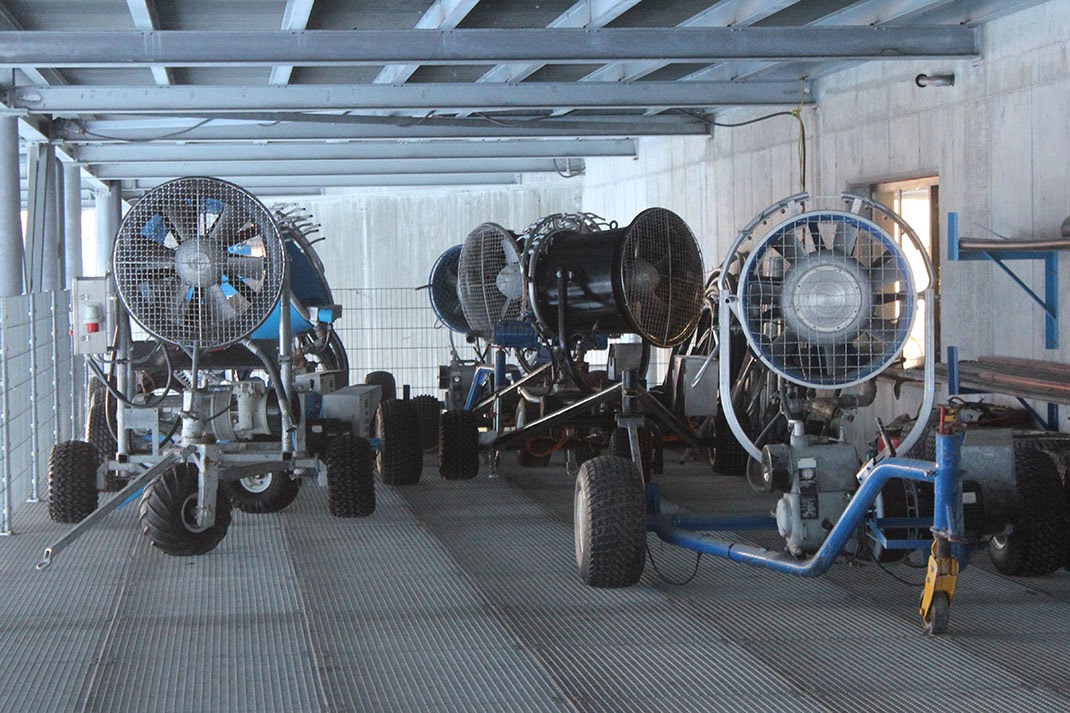
[Image: Photo by Danny Lane].
This is all just part of the dramaturgical stagecraft of Switzerland: winter becomes a precisely choreographed thermal event that just happens to take on spatial characteristics amenable to downhill skiing.
In any case, there are nearly 1,000 individual snow-production machines in Zermatt, only one of which is The Snowmaker. The whole system is controlled from a central computer, apparently operated by one wizard-like figure who is really just a stoned twentysomething in a wool hat, turning different parameters on and off and spraying whole new European landscapes into existence outside.

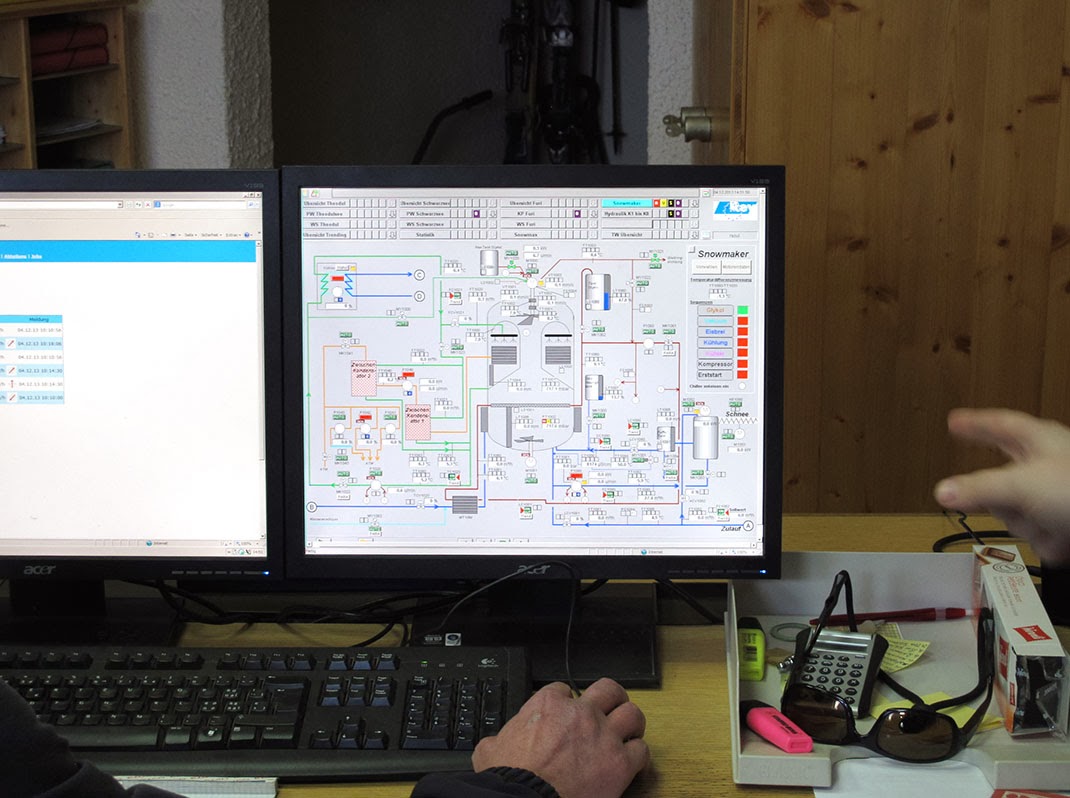
[Images: (top) Photo by Danny Lane; (bottom) photo by Kyle Buchanan].
It's like the Sorcerer's Apprentice at the top of the world, 3D-printing recreational mountainscapes. The landscape is a computer he alone knows how to use.
Imagine if Thomas Mann's Magic Mountain had taken place amidst a massive, artificially maintained and 3D-printed winter, and you might begin to grasp the unearthly strangeness here, the surreal mechanical goings-on at great altitude.
What appears, at first glance, to be a simple ski holiday actually turns out, upon later inspection, to be a landscape-scale encounter with artificiality and snow-based 3D-printing.
(See also Gizmodo, where these photographs were first published; thanks to Mara Kanthak for her help with translation in Switzerland).
Wednesday, January 15. 2014
Does humanity’s tightening grip on the fate of nature portend new sources of global conflict? | #climate #geoengineering
-----
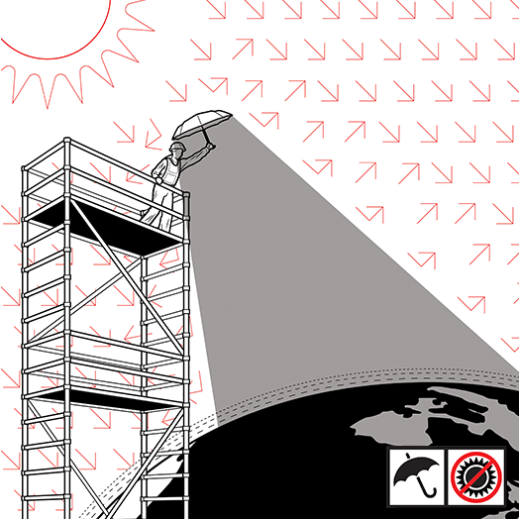
Illustration by McKibillo
More than a decade ago, Paul Crutzen, who won the 1995 Nobel Prize in chemistry for his research on the destruction of stratospheric ozone, popularized the term “Anthropocene” for Earth’s current geologic state. One of the more radical extensions of his idea—that human activity now dominates the planet’s forests, oceans, freshwater networks, and ecosystems—is the controversial concept of geoengineering, deliberately tinkering with the climate to counteract global warming. The logic is straightforward: if humans control the fate of natural systems, shouldn’t we use our technology to help save them from the risks of climate change, given that there’s little hope of cutting emissions enough to stop the warming trend?
In recent years a number of scientists—including Crutzen himself in 2006—have called for preliminary research into geoengineering techniques such as using sulfur particles to reflect some of the sun’s light back into space. With the publication of A Case for Climate Engineering, David Keith, a Harvard physicist and energy policy expert, goes one step further. He lays out arguments—albeit hedged with caveats—for actually deploying geoengineering. He says that releasing sun-blocking aerosol particles in the stratosphere (see “A Cheap and Easy Plan to Stop Global Warming,” March/April 2013) “is doable in the narrow technocratic sense.”
Indeed, Keith is steadfastly confident about the technical details. He says a program to cool the planet with sulfate aerosols—solar geoengineering—could probably begin by 2020, using a small fleet of planes flying regular aerosol-spraying missions at high altitudes. Since sunlight drives precipitation, could reducing it lead to droughts? Not if geoengineering was used sparingly, he concludes.
Australian ethicist Clive Hamilton calls the book “chilling” in its technocratic confidence. But Keith and Hamilton do agree on one thing: solar geoengineering could be a major geopolitical issue in the 21st century, akin to nuclear weapons during the 20th—and the politics could, if anything, be even trickier and less predictable. The reason is that compared with acquiring nuclear weapons, the technology is relatively easy to deploy. “Almost any nation could afford to alter the Earth’s climate,” Keith writes. That fact, he says, “may accelerate the shifting balance of global power, raising security concerns that could, in the worst case, lead to war.”
Thing reviewed
A Case for Climate Engineering
David Keith MIT Press, 2013
The potential sources of conflict are myriad. Who will control Earth’s thermostat? What if one country blames geoengineering for famine-inducing droughts or devastating hurricanes? No treaties ban climate engineering explicitly. And it’s not clear how such a treaty would operate.
Keith professes ambivalence about whether humans are truly able to wield such powerful technology wisely. Yet he feels that the more information scientists uncover about the risks of geoengineering, the lower the chances the technology will be used recklessly. Though his book leaves unanswered many of the questions that arise over how to govern geoengineering, a policy paper that he published in Science last year goes further to address them: he and a coauthor proposed government authority over research and a moratorium on large-scale geoengineering but said there should be no treaties regulating small-scale experiments.
Hamilton says this approach would lead nations on a path toward the conflict that he thinks would inevitably surround geoengineering. Allowing lightly regulated small experiments, he suggests, could undermine the urgency of political efforts toward cutting emissions. This, in turn, increases the possibility that geoengineering will be used, since failing to restrain emissions will leave temperatures rising. Hamilton accuses Keith of seeking a “naïve … cocoon of scientific neutrality” and says researchers cannot “absolve themselves of responsibility for how their schemes might be used or misused in the future.”
That may be true, but Keith deserves credit for directing attention to ideas he knows are dangerous. Accepting the concept of the Anthropocene means accepting that humans have the responsibility to find technological fixes for disasters they have created. But little progress has been made toward a process for rationally supervising such activity on a global scale. We need a more open discussion about a seemingly outlandish but real geopolitical risk: war over climate engineering.
Personal comment:
"Who will control Earth’s thermostat?" Oh well, following yesterday's news, I would suggest Google, they have "smart" technology ...
By the way, will we also reach some "climate neutrality quash" one day (compared to "net neutrality quashed" by a federal court), once global weather will definitely be an artifact and a product?
Sunday, September 01. 2013
"fabric | ch – Severe Weather Harvesting", The Price Victor Vasarely of Art in Public Space (Marseille, 2013)
fabric | rblg
This blog is the survey website of fabric | ch - studio for architecture, interaction and research.
We curate and reblog articles, researches, writings, exhibitions and projects that we notice and find interesting during our everyday practice and readings.
Most articles concern the intertwined fields of architecture, territory, art, interaction design, thinking and science. From time to time, we also publish documentation about our own work and research, immersed among these related resources and inspirations.
This website is used by fabric | ch as archive, references and resources. It is shared with all those interested in the same topics as we are, in the hope that they will also find valuable references and content in it.
Quicksearch
Categories
Calendar
|
|
July '25 | |||||
| Mon | Tue | Wed | Thu | Fri | Sat | Sun |
| 1 | 2 | 3 | 4 | 5 | 6 | |
| 7 | 8 | 9 | 10 | 11 | 12 | 13 |
| 14 | 15 | 16 | 17 | 18 | 19 | 20 |
| 21 | 22 | 23 | 24 | 25 | 26 | 27 |
| 28 | 29 | 30 | 31 | |||









